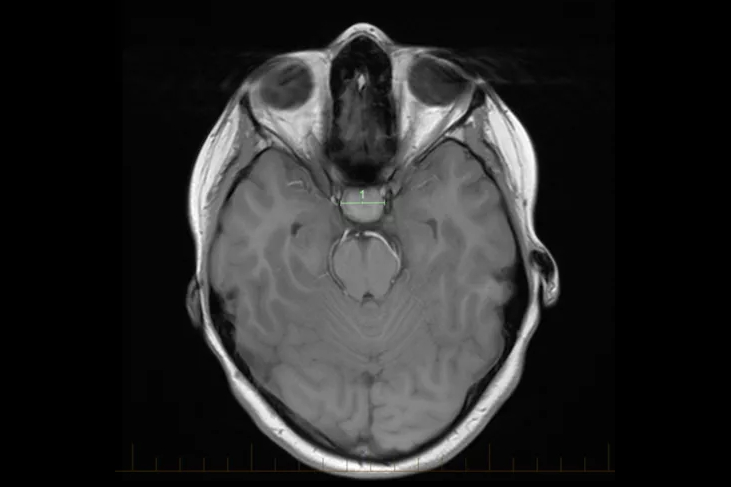Cranopharyngeal tumor is a benign congenital brain tumor that grows from the remnants of primitive cells from the top of the pharynx, and remains in the parts of the brain during the creation of the fetus. And anointing for the whole body.
The tumor can be a mass of tissue, or a cyst containing fluid and cholesterol, or both. It is located adjacent to the tumor of the optic nerves, the intersection of the optic nerves and their extensions, and the hypothalamic region, and at the top of the third cerebral ventricular cavity.
The tumor affects the organs mentioned above, which leads to the emergence of pathological symptoms. When there is pressure from the tumor on the pituitary gland, symptoms of hormonal disorders arise, and when pressure occurs on the optic nerves, it leads to visual disturbance, and pressure on the hypothalamic region leads to increased obesity in children or poor growth, and a disorder of the entire body’s physiology. The tumor may cause hydrocephalus when the tumor extends into the third ventricular cavity of the cerebral spinal fluid as a result of fluid retention within the brain, which requires urgent surgical intervention to drain the cerebral spinal fluid.
The disease usually occurs in children, but it may affect, in small proportions, all other ages.
Therapeutic methods for craniopharyngioma:
- الجراحة المجهرية العصبية المقنّنة
And it is done under general anesthesia, through a small wound in the eyebrow, and a small hole in the skull in the forehead. We can remove the tumor completely or partially, and we recommend this method when the tumor is an endocrine tissue mass, and among the complications of this surgery is the inability to completely remove the tumor due to its strong adhesion to the above-mentioned sensitive areas adjacent to the tumor and the occurrence of hormonal complications - Corrective surgery (stereotactic) to drain
We recommend this modern technique for cystic tumors in whole or in part, in order to avoid the complications of the aforementioned traditional microsurgery.
This delicate surgery is done by installing a stereotactic device on the patient's head using local anesthesia, and performing a three-dimensional magnetic resonance imaging in order to calculate the three coordinates of the center of the tumor cyst, and by inserting a drainage tube from an opening at the top of the skull to the center of the tumor cyst and connecting the tube to a small plastic tank with a diameter of 2 cm and the shape of an implanted hemisphere under the skull's fur.
After completing this cultivation, we withdraw the fluid from inside the tumoral cyst with a special needle, which leads to shrinkage of the tumor and the disappearance of the symptoms resulting from the pressure of the tumor on the organs adjacent to it and their improvement. Vision usually improves immediately after the procedure, and we repeat the withdrawal of fluid from the reservoir under the scalp until the treatment is completed, by injecting the cyst with chemotherapy, radioactive liquid, or what was recently discovered, which is injecting the tumor cyst with (Interferon) at specific time intervals that depend on the age of the patient , and the size of the cyst. The success rate of recovery with this modern technique reaches more than 90%. - Gamma-knife radiosurgery for craniopharyngioma:
Partial resection of the tumor or drainage of the fluid from the cystic cavity of the tumor does not mean cure, and therefore the completion of tumor treatment requires either injections of interferon, as mentioned earlier, or killing the tumor in its bud by radiosurgery aimed at the gamma knife.
With this technology, we direct the targeted and lethal gamma rays at the tumor only, with extreme accuracy, to kill the tumor in its cradle inside the brain, without exposing the adjacent tissues to any damage, in one session, without general anesthesia, without wounding, bleeding, infections, or any neurological symptoms, as is the case with microsurgery, and without falling head hair or fatigue. As a complication of conventional radiation therapy to the brain

